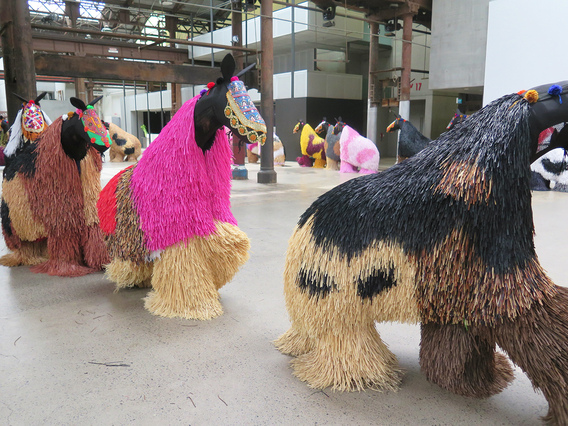
R
E
V N
E
X
T
American performance artist, dancer and fabric sculptor Nick Cave metaphorically rode into Sydney earlier this month on the back of a herd of brightly colored exuberant horses for three performances of his vivacious Heard·Syd (2016)—one of which was planned for the streets of Sydney’s Central Business District. Heard·Syd is the latest iteration of Heard·NY, a loosely atavistic-structured dance, which was first performed in New York in 2013 to celebrate the centenary of Grand Central Terminal. Since then Cave’s lavishly costumed horses—30 in total, each with two dancers performing as the front and back end of the animal—have cantered through Hong Kong, Denver and Detroit. Heard·Syd marked Cave’s first major work to be presented in Australia and will not be the last, according to Lisa Havilah, director of Carriageworks, the organizing institution.
Cave’s horses are swathed head to foot in his now almost signature “sound suits,” here made from colored raffia, and owe their genesis to Twigs, a piece of wearable sculpture he made in 1992. Cave explained during the media performance at Carriageworks that when he wore the suit, the twigs made a sound as he moved. The horse sound suits are no exception—they boisterously swished, lending the horses an other-worldly presence. What visually results is a cross somewhere between Chewbacca, the hairy Wookiee from the Star Wars movies, and the Green Man, from British folk tradition. Throw in tribal influences from African ceremonial costumes, Tibetan textiles and Papua New Guinea tribesmen’s vivid body paint and you arrive at Cave’s horses, which dazzle in their own particular synthesis of color and movement.
The horses begin the performance slowly and rhythmically, a barely controlled dressage to a repetitive drumming supplied by an Australian Pacific Islanders percussion band. The music for each iteration of the performance is different. In Heard·Syd, the sound swelled until it became an almost frenzied cacophony at which time the rear end of the horses broke free and danced wildly with foot stomping and arm swinging bravado, presenting a scene that was transformative in its pizzazz and spectacular in its dreamy majesty.
What the local office workers made of the performance that took place at the city’s Pitt Street Mall on November 10, as they rushed to catch the 5 pm train from the Central Station to the burbs, remains to be known. But that is precisely the point, according to Cave. “The idea [for Heard·NY] originated from me thinking about a daily commute. You go to work, get on a train and go home. Then I thought about transition . . . A shift in the way of operating . . . refuel, jump start,” he said in his quiet intonation. While Heard·Syd was conceived to liberate the senses in the blink of an eye, Cave was at pains to point out that his practice it is not all about conspicuous revelry. There is a dark and serious undertow to much of what he does.
The original Twigs sound suit was made by Cave in the wake of the Los Angeles Police Department’s beating of African-American construction worker Rodney King, following a police car chase, in 1992. Today, almost nightly on our television screens, we are again seeing African-Americans being shot and killed for what seems minor misdemeanors.
Little seems to have changed since 1992, other than that the target of vilification in America seems to have grown broader to include Muslims and Mexicans, as the country shifts to the far right.
In direct response to this shift, Cave recently opened “Nick Cave: Until,” at the Massachusetts Museum of Contemporary Art (MASSMoCA), a vast, immersive installation made from thousands of found bits and pieces gathered by his studio, and which remains on view until September 2017. In a space the size of a football field, there are “16,000 wind spinners; millions of plastic pony beads; thousands of ceramic birds, fruit, and animals; 13 gilded pigs; more than 10 miles of crystals; 24 chandeliers; 1 crocodile; and 17 cast-iron lawn jockeys,” according to MASSMoCA’s website. “Until” is Cave’s largest installation to date, and yet there isn’t a sound suit in sight.
“Until” is “a political based project talking about gun violence in the USA, looking at people of color and . . . this confrontation that they run into with police. It is also a project that is a space for gathering, to have conversations around gun violence and issues of race. It is very magical and daunting at the same time. It is immersive and kinetic, but a large part of the project is working to create . . . safe havens within it, ” Cave explained.
This was Cave’s project that Havilah alluded to earlier that will be coming to Carriageworks in the future, scheduled for 2018. The experience of walking though “Nick Cave: Until,” with its quiet and reflective spaces will prove a sharp contrast to the audacious, exuberant cacophony of Cave’s horses that stampeded through Carriageworks and along Pitt Street Mall in Sydney’s Central Business District.
Nick Cave’s Heard·Syd took place at Carriageworks, Sydney, on November 10th and 12th, 2016.
To read more articles from our archive, go to our digital library: https://library.artasiapacific.com/





